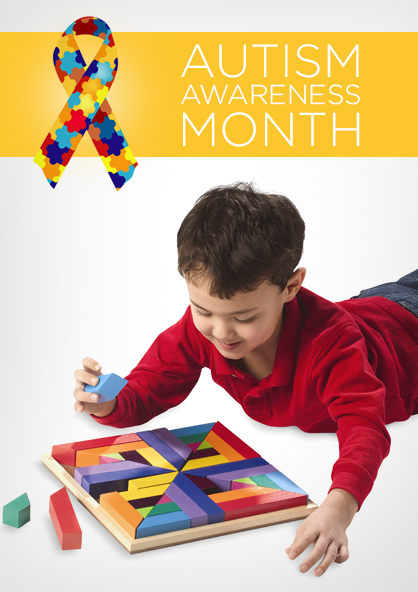Autism Awareness Month: Living with Autism
Lindsey Nebeker knows she’s different. Having suffered from autism her whole life, she may not realize what life without autism is like, but a sense of separation and a feeling of being out-of-place remain.
“Living with autism, or having a loved one with autism, is not easy,” Nebeker said. “It can be extremely difficult. But to be viewed as alien, epidemic, a hopeless case… that hurts us deeply. We need to be embraced as whole, not viewed as broken. We need to be appreciated for who we already are, not for what others wish we could have been. And we need to feel accepted, since acceptance is a basic human right.”
A complex developmental disability, autism impacts an individual’s ability to communicate and interact with their peers.
Society has come a long way in its reaction to autism even in the past ten years. While most have heard of the disorder, however, few realize what it truly means to suffer from it. “This is why it is important for those of us familiar with autism to advocate, inform and others about autism,” Nebeker explained. “The goal is to convince all to recognize the basic human rights we are entitled to.”
The real tragedy, according to Nebeker, is that people who experience autism are viewed as experiencing a tragedy. She prefers to interpret autism as a rose having sharp thorns and a tough stem. However, when the flower is in full bloom, one may find incredible beauty.
“Autism contains a mysterious, unpredictable element,” she said. “There are some aspects of autism which have been extremely difficult, and other aspects which serve as sparks to my creativity.”
One of the greatest hurdles she faces is being able to understand others and being understood in return.
“Every one of us wants to feel validated, and the struggle to not communicate effectively in a ‘language’ the rest of the world can comprehend hinders our voices from being heard and validated,” Nebeker asserted.
As a spectrum disorder, autism causes its sufferers to have a different experience at a varying intensity. Nebeker’s brother James, for example, likewise has the disability, but his autism is far more intense: He does not speak and, unlike his sister, is forced to live in community housing with full-time support staff, despite being in his late twenties.
“Even though my brother and I share the same diagnosis, our lives have led very different paths,” she said. “For that reason, I appreciate the reality of how wide and vast the autism spectrum really is.”
Nebeker has learned to deal with her brother’s disability on many levels. She practices “mindfulness”: Just because he does not speak does not mean he has no voice or cannot hear the conversation. Whether or not James appears to be engaged in the conversation, it is important to act as if he is fully present and participating.
“I cannot deny that our relationship was different from most sibling relationships, and I cannot deny that I wished we had a more connected relationship,” Nebeker maintained. “However, I have no idea what it is like to not grow up with someone like James. It is the only sibling experience I know. So I choose not to stress on comparing our relationship to the brother-sister relationship that could have been. I love him regardless.”
Nebeker made the decision to become public about her disability while in her early twenties. Since the point, she has become a full-fledged advocate for autism, giving speaking engagements and workshops across the country. Finding the work rewarding, she appreciates the chance to encourage others and connect with her autistic peers.
“I try to encourage other autistic individuals that it is not about society’s definition of potential, achievement and success. It’s about personal potential, personal achievement and personal success,” she maintained.
Nebeker and her brother grew up in Japan, where resources were scarce. Moving to the United States, she was excited to discover the Autism Society, a nonprofit dedicated to improving the lives of those affected by autism. At the time, the society was the leading autism organization in the nation. Today she is a proud staff member and has even met her boyfriend of eight years through an Autism Society National Conference.
“Never would have I imagined that I was going to receive an opportunity to work for the Autism Society. So far, it has been a positive learning experience,” Nebeker enthused.
Approximately 1 percent of U.S. children ages 3 to 17 have an autism spectrum disorder, and the prevalence has risen to one in every 88 births. The warning signs of autism typically manifest during a child’s first three years of life. While autism remains with its sufferers for the rest of their lives, the disorder is treatable. Knowing the signs and identifying the disability early can change children’s lives.
“We increase the public’s awareness about the day-to-day issues faced by people on the spectrum, advocating for appropriate services for individuals across the lifespan, and providing the latest information regarding treatment, education, research and advocacy,” the Autism Society said.
As autism continues to grow in the United States – current statistics estimate an annual growth of 10 to 17 percent, making it the country’s fastest-growing developmental disability – we must, as a society, figure out how to best serve the individuals and their families, who will need a lifetime of support. The annual cost of the disorder in ten years is predicted to be $200 to $400 billion.
For more information, visit www.autism-society.org.
Tagged in: causes, philanthropy, autism, autism awareness month,

LadyLUX



